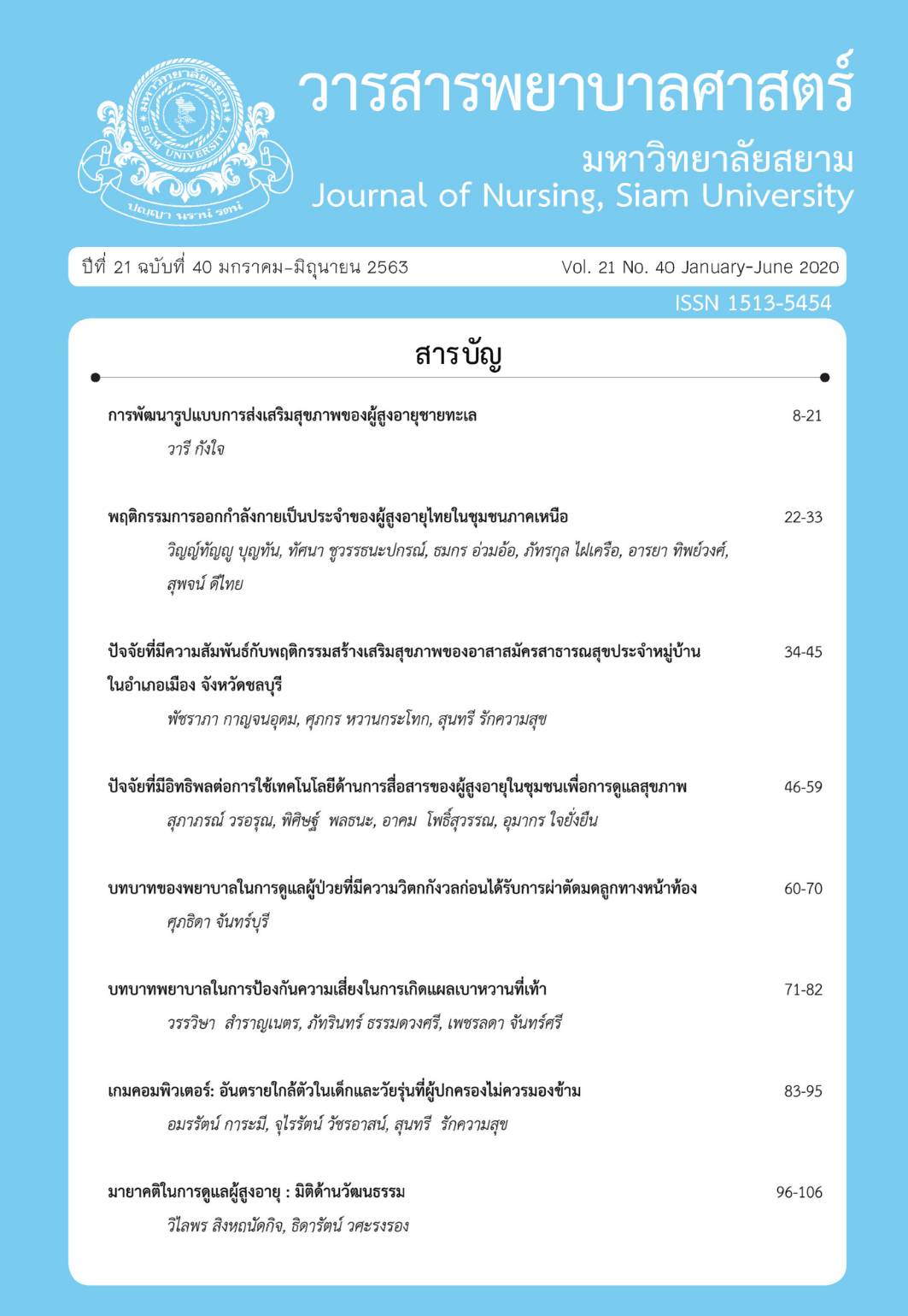The Myth of Geriatric Care: Cultural Dimension
DOI:
https://doi.org/10.14456/jnsu.v21i40.243552Keywords:
Active ageing, Positive attitude, CultureAbstract
This article is intended for readers to know the concept of active ageing and understand the elderly in the cultural dimension that lead to adjust the attitude towards the elderly to be positive. Moreover, to promote good health and value in the elderly which including the role of participation of all sectors in the empowerment active ageing.
Valuing the elderly depends on the attitudes of different people. However the process to optimize the elderly to value themselves according to the concept of active aging, depend on cultural factors that will help to promote or hinder behavior or actions based on the power. For developing the potential and count value to the elderly, not only focus on physical and economic but should take account for the social and cultural dimensions. Especially in terms of knowledge bank and promote the older to engage in social activity, as well as construct a positive attitude to promote the potential of the elderly
References
Narushima, M., Liu, J., & Diestelkamp, N. (2018). Lifelong learning in active ageing discourse: its conserving effect on wellbeing, health and vulnerability. Ageing and Society, 38(651-675).
World Health Organization. (2002). Active ageing: a policy framework. Retrieved from https://apps.who.int/iris/bitstream/handle/10665/67215/WHO_NMH_NPH_02.8.pdf?sequence=1
กมลชนก ขำสุวรรณ. (2559). เวทีวิจัยประชากรและสังคม การสร้างภาพลักษณ์เชิงบวกของผู้สูงอายุไทย : ชมรมคลังปัญญาผู้สูงอายุจังหวัด. จดหมายข่าวย้อนหลัง, 36(4).
กลุ่มประสานและติดตามสารสนเทศ ศูนย์สารสนเทศยุทธศาสตร์ภาครัฐ สำนักงานสถิติแห่งชาติ. (2560). ดัชนีพฤฒพลังผู้สูงอายุไทย 2560
จุฑารัตน์ แสงทอง. (2558). การเห็นคุณค่าในตนเองของผู้สูงอายุผ่านบทบาทอาสาสมัคร. สารอาศรมวัฒนธรรมวลัยลักษณ์, 15(2), 73-89.
บุษยา วงษ์ชวลิตกุล, วิรัช สงวนวงศ์วาน, สิริรัตน์ ฉัตรชัยสุชา, ธนกร ลิ้มศรัณย์, สิริวดี ไทยสมัคร, และคณิต เรืองขจร.(2559). ความรู้และทัศนคติของผู้ดูแลผู้สูงอายุกรณีศึกษาผู้ดูแลผู้สูงอายุในสถานสงเคราะห์คนชราบ้านธรรมปกรณ์โพธิ์กลาง และสถานสงเคราะห์คนชราบ้านธรรมปกรณ์วัดม่วง
จังหวัดนครราชสีมา. วารสารวิชาการบริหารธุรกิจ, 5(2), 74-92.
เบญจมาศ ยศเสนา. (2559). การเห็นคุณค่าผู้สูงอายุ. วารสารการวิจัยเพื่อพัฒนาชุมชน, 9(1), 1-14.
พระครูสิริภูรินิทัศน์. ( 2563). โรงเรียนผู้สูงอายุกับการเรียนรู้พัฒนาคุณภาพชีวิต. วารสารวิจัยวิชาการ, 3(2), 151-160.
รศรินทร์ เกรย์, อุมาภรณ์ ภัทรวาณิชย์, เฉลิมพล แจ่มจันทร์, & เรวดี สุวรรณนพเก้า. (2556). มโนทัศน์ใหม่ของนิยามผู้สูงอายุ: มุมมองใหม่เชิงจิตวิทยาสังคมและสุขภาพ
วิพรรณ ประจวบเหมาะ. (2556). รายงานประจำปี สถานการณ์ผู้สูงอายุไทย พ.ศ. 2555
วิภานันท์ ม่วงสกุล. (2558). การพัฒนาศักยภาพผู้สูงอายุที่อาศัยอยู่ตามลำพังด้วยแนวคิดพฤฒพลัง. วารสารวิจัยสังคม, 38(2), 93-112.
วิภารัตน์ สุวรรณไวพัฒนะ, วิภาวี พลแก้ว, & วิรุฬจิตรา อุ่นจางวาง. (2563). ผลของสถานการณ์จำลองการเป็นผู้สูงอายุที่มีต่อทัศนคติ ความเป็นผู้สูงอายุของเด็กวัยรุ่นตอนกลาง. วารสารวิจัยทางวิทยาศาสตร์สุขภาพ, 14(1), 97-105.
สถาบันวิจัยประชากรและสังคม. (2562). สุขภาพคนไทย 2562 : สื่อสังคม สื่อสองคม สุขภาวะคนไทยในโลกโซเชียล
สภาปฏิรูปแห่งชาติ. (2558). วาระปฏฺรูปที่ 30: การปฏิรูประบบเพื่อรองรับสังคมสูงวัย
สมฤทัย บุญสุธากุล. ฐานข้อมูลทางวิชาการเพื่อสนับสนุนการดูแลรักษาพยาบาลผู้สูงอายุแบบครบวงจรเพื่อสนับสนุนการดำเนินงานของคณะกรรมาธิการการสาธารณสุข สํานักงานเลขาธิการสภานิติบัญญัติแห่งชาติ (Ed.) Retrieved from
https://www.senate.go.th/assets/portals/28/fileups/146/files/ฐานข้อมูลเชิงวิชาการ.pdf
สโรชพันธุ์ สุภาวรรณ์, & ชไมพร กาญจนกิจสกุล. (2557). การประกอบสร้างภาพลักษณ์ของผู้สูงอายุ. วารสารสังคมศาสตร์, 10(1), 91-136.
สำนักงานสถิติแห่งชาติ. (2563). สถิติประชากรศาสตร์ ประชากรและเคหะ.
หฤทัย กงมหา, กรรณิการ์ หาญสูงเนิน, วิไลพร รังควัต, & ประทุ่ม กงมหา. (2561). การพัฒนารูปแบบการส่งเสริมพฤฒพลังในผู้สูงอายุ อำเภอเมือง จังหวัดนครราชสีมา. วารสารมหาวิทยาลัยนครพนม ฉบับการประชุมวิชาการครบรอบ 25 ปี, 54-62.
อมร สุวรรณนิมิต, นงเยาว์ มีเทียน, & สุภาพร อาญาเมือง. (2561). การพัฒนารูปแบบการดูแลผู้สูงอายุในชุมชน. วารสารมหาวิทยาลัยนครพนม ฉบับการประชุมวิชาการครบรอบ 25 ปี, 46-53.
Downloads
Published
How to Cite
Issue
Section
License
Content and information published in the Journal of Nursing, Siam University is the comment and responsibility of the authors.
Articles, information, images, etc. published in the Journal of Nursing. Siam University is the copyright of the Journal of Nursing, Siam University. If any person or entity wants to take all or part of it for publication for any purposes, please reference the Journal of Nursing, Siam University.



